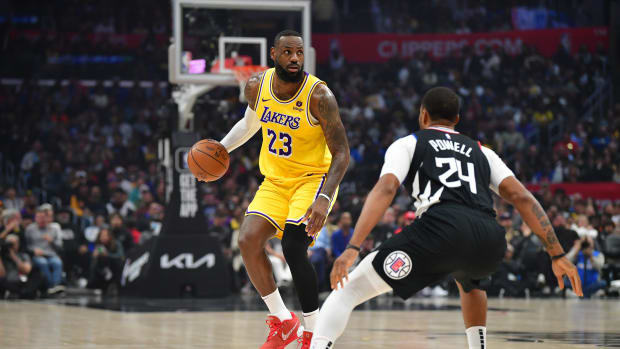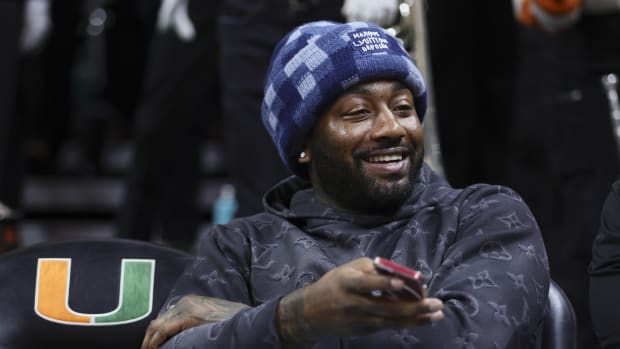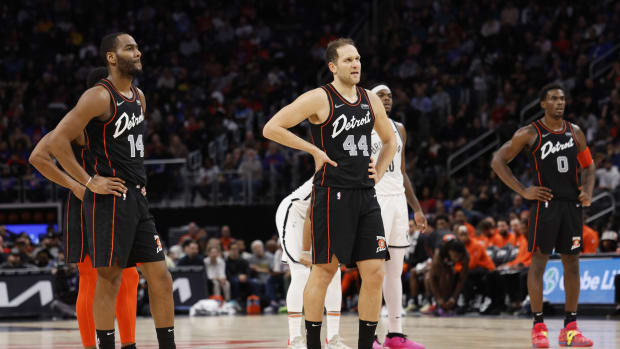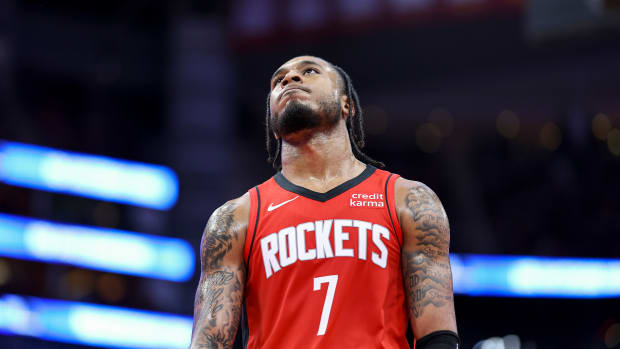Building USA Basketball's Dream Team for the 2020 Olympics
LAS VEGAS — If attendance was mandatory, USA Basketball’s minicamp at UNLV this week would be overflowing with explosive storylines: LeBron James would be meeting the media for the first time since joining the Lakers, Gregg Popovich and Kawhi Leonard would be sharing the court after their highly-publicized divorce, and Stephen Curry and Chris Paul would be going head-to-head after their shimmy-off in the Western Conference finals.
Alas, James, Leonard, Curry, Draymond Green and other A-listers are reportedly expected to skip the three-day meet and greet, thereby shifting some of the attention from offseason fireworks to USA Basketball’s future under Popovich, who officially took the reins from Duke’s Mike Krzyzewski following the 2016 Rio Olympics.
In experience and temperament, Popovich is the ideal USA Basketball coach, but he inherits a job with an expectation of perfection. Under Krzyzewski, USA Basketball went 88–1, winning gold at three straight Olympics (2008, 2012, 2016) and two straight FIBA World Championships (2010, 2014). While USAB hasn’t lost a game at a major competition since 2006, they flirted with disaster in Rio, scoring narrow wins over Serbia, France and Spain. The 2016 team—which competed without James and Curry—failed to captivate like previous Dream Teams, and their gold felt more like a relief rather than a source of national pride.
Back in April, USAB announced a 35-man player pool from which it would select 12-man rosters for the 2019 FIBA World Cup in China and the 2020 Olympics in Japan. These pools have proven to be elastic in the past, as they have featured late additions to compensate for injuries and schedule conflicts. Nevertheless, the current pool is so loaded that Popovich and company could theoretically construct two separate rosters capable of capturing gold and silver in 2020.
With that remarkable depth in mind, here’s how The Crossover would construct USA’s Dream Team for Tokyo 2020. The 12 roster players are listed in order of importance, with consideration given to their talent, star power, positional fit, injury history, previous USA Basketball experience, and age in 2020. Five alternates are also listed to account for withdrawals or health issues. Only members of USAB’s current player pool were considered.
No. 1: LeBron James (age 35 in 2020)
When James withdrew from the 2016 Olympic team, it initially felt like his storied USAB career might be over. Now, a comeback hardly seems far-fetched. James remains basketball’s best player and biggest star, he just signed a new max contract that runs through 2022, and he shares a mutual respect and affection with Popovich. Even accounting for some age-related slippage in his game between now and 2020, James is likely to be a more effective all-around player at age 35 than, say, Kobe Bryant was at age 33 during the 2012 London Olympics. His mere presence would be one of Tokyo’s biggest storylines.
Best-case scenario: Popovich treats James to a few glasses of expensive wine and reminds him that Michael Jordan retired with two Olympic gold medals. James could move past the “Ghost from Chicago” by claiming his third in Tokyo. It’s also worth noting that James’s move to the Western Conference could free up some downtime in his summers. If Golden State’s dominance continues as expected, James might not be playing into June 2019 and 2020 like he did every year from 2011 to 2018.
Will LeBron Still be a Top-10 Player in Five Years?
No. 2: Anthony Davis (age 27 in 2020)
If James is the ideal 2020 headliner, Davis is the biggest X-factor. First, he will be smack in his prime and has a decent chance to be viewed as the sport’s best player two years from now. Second, and perhaps more importantly, he is easily USAB’s leading big man. DeMarcus Cousins will be working back from a torn Achilles. DeAndre Jordan will be 32. Draymond Green, who struggled in Rio, will be 30 and potentially coming off six straight Finals appearances. The oft-injured Kevin Love will be 31.
Meanwhile, Andre Drummond is physical but less skilled, Myles Turner is intriguing but unproven, and the many talented bigs in the 2018 draft are total unknowns on the international stage. Don’t forget: Karl-Anthony Towns, Joel Embiid, Kristaps Porzingis, Nikola Jokic, Rudy Gobert, Steven Adams, Clint Capela and Jonas Valanciunas, among others, are all off the table due to international ties. With Davis, who won gold in 2012, USAB can reasonably expect to have advantages at all five positions against whomever they face in 2020. Without him, they would need to get creative in dealing with the many international centers who are stars in the making.
No. 3: Stephen Curry (age 32 in 2020)
Curry’s absence from the 2016 Rio team was a real killer. At the time, he was coming off a 73-win season, a unanimous MVP selection, a heartbreaking Finals defeat, and a successful recruitment of Kevin Durant. As both an individual player and an icon, he was at his zenith and he would have owned Brazil. Such a shame.
Although Curry won gold at the 2010 and 2014 World Championships, Tokyo 2020 likely represents his last chance to win an Olympic gold. Aside from an elusive Finals MVP, it’s the only meaningful award missing from his trophy case. Will the prospect of chasing gold be enough to pull him away from his family commitments?
No. 4: Kevin Durant (age 31 in 2020)
The odds-on favorite to be the best player in basketball in 2020, Durant proved that he could carry USAB to gold without James and Curry in 2016. If necessary, he could do it again in Tokyo, as his smooth shooting makes a mockery of the international three-point line and his length allows him to engulf foreign competition. Durant is unfair in the NBA. He’s completely impossible in the Olympics.
Even so, it would be more fun to cast him as a supporting sniper on a team loaded with A-listers. He’s at his most entertaining internationally when he can take over games with bursts of unstoppable one-on-one play. At times, the Rio team’s offense dragged when his level of engagement wavered and his less-accomplished teammates didn’t know how to respond.
No. 5: James Harden (age 30 in 2020)
Harden, the reigning 2018 NBA MVP, won gold at the 2012 Olympics and 2014 World Championships, but sat out in 2016. Like Curry, he’s yet to compete on the global stage since ascending to his status as a top-five player. It’s easy to picture him turning the rest of the world into Wesley Johnsons with his trademark crossover dribbles and step-back threes.
Aside from James, Harden is USAB’s top scorer/passer hybrid, and he would work well on the ball or spotting up alongside Curry. USAB wouldn’t need Harden to be the alpha and omega like he is in Houston, but his isolation scoring ability would be helpful in tense late-game situations and he would have the benefit of rarely facing double teams with so many skilled teammates.
No. 6: Russell Westbrook (age 31 in 2020)
On this Dream Team, Westbrook wouldn’t be the best pure passer or the most efficient scorer. Frankly, he wouldn’t even be a starter if all five players listed above decided to play. However, his relentless energy and imposing style would be crucial to USAB’s success, making him a perfect sixth man.
While Westbrook’s passion and intensity can sometimes get the better of him in the NBA, his margin for error in the Olympics would be significantly larger. How many countries have guards who can avoid being steamrolled by the Westbrook express? Not many. There’s no question USAB missed his reliable tenacity in Rio.
Keep in mind: Westbrook hasn’t suited up for the National Team since winning gold at the 2010 World Championships and the 2012 Olympics. Last summer, he agreed to a five-year, $200+ million contract extension that keeps him in Oklahoma City through 2023. Will the security of that deal provide reassurance that he can compete in Tokyo or will his massive salary and burden in OKC lead him to exercise caution?
No. 7: Klay Thompson (age 30 in 2020)
Thompson is listed this high thanks to his perfect fit playing alongside ball-dominant stars. The Warriors’ guard is an ideal 3-and-D option, capable of pouring in threes from the shorter stripe and defending all three perimeter positions. He can score in volume without requiring lots of touches, he demands constant defensive attention when he moves without the ball, and he won’t complain or slack off if USAB’s alphas forget to involve him for long stretches.
Helping Thompson’s case is his USAB experience: he won gold at the 2014 World Championships and the 2016 Olympics, although he suffered through a shooting slump in Rio.
Seventeen Steps to Embracing Dwight Howard and the Wizards' Offseason
No. 8: Kyrie Irving (age 28 in 2020)
The chief concern with this roster so far is that it’s on the older side. Historically, USAB has been at its best when it turns pressure defense into easy offense and makes full use of its athletic advantages in transition. Westbrook’s force of will could help counteract the deliberate style preferred by James and Harden, while calculated doses of Irving’s on-ball dribbling wizardry and end-to-end speed could keep USAB at its preferred pace.
Irving, a gold medalist in 2014 and 2016, is obviously a question mark for 2020 given his long list of injury concerns, including a recent knee surgery. If he can’t go, John Wall would be another quality pace-setting option.
No. 9: Paul George (age 30 in 2020)
Among the remaining wing candidates, George brings the best mix of USAB experience, skillset, and positional fit. Kawhi Leonard is a superior all-around player, but George isn’t held back by major dependability questions or a lingering long-term injury. Jimmy Butler is a better individual scorer, but George is a better shooter and more comfortable playing off the ball. Bradley Beal has a similar two-way profile, but George is bigger, longer and better suited to guarding elite wings.
George won gold in 2016, completing a remarkable comeback from a devastating leg injury he suffered during a 2014 USAB showcase in Las Vegas. He would be an exceptional candidate as a designated wing defender and lineup Swiss-Army Knife in Tokyo, and he has some measure of freedom after locking in with the Thunder through 2022.
No. 10: Draymond Green (age 30 in 2020)
The idea of Olympic Draymond was much, much better than the reality of Olympic Draymond. In theory, Green is the ideal international center thanks to his energy, defensive intelligence and disruption, rim protection, unselfish offensive approach, and comfort on the perimeter. In practice, Green played fewer than 10 MPG in the 2016 Rio Olympics and barely had an impact. Perhaps he was still hungover from two straight months of “3-1” jokes.
While Davis, Green, Durant and George can all log minutes at the four or five, USAB should cover its bases from a roster balance standpoint by bringing multiple reserve big men for match-up purposes. If Green is willing, the 2017 Defensive Player of the Year deserves a second chance.
No. 11: Kevin Love (age 31 in 2020)
This roster needs at least one more big and there are a bunch of reasonable candidates: Love, Cousins, Drummond and Jordan, to name four with prior USAB experience. Selecting based on age curves would favor Drummond, as he will be 26 in 2020. Unfortunately, Detroit’s center is not an ideal fit with this roster: he’s not a versatile defender and his lack of range kills offensive spacing. Those limitations likely wouldn’t be fatal to USAB’s success, but they undercut his utility.
Love, on the other hand, can function in a five-out offense, he doesn’t need heavy touches to remain engaged, and he has improved somewhat as a defender in space. While a little undersized as a five, the 2010 and 2012 gold medalist can rebound in volume and launch fast breaks with his renowned outlet passing. Injuries and/or age might prevent him from competing in 2020, but he’s a cleaner fit than Drummond or Jordan, and he isn’t rehabilitating from a potentially career-altering injury like Cousins.
No. 12: Chris Paul (age 35 in 2020)
USAB has regularly devoted a roster spot or two to the likes of Jason Kidd, Chauncey Billups and Andre Iguodala, veterans who function as high-level glue guys thanks to their institutional knowledge and basketball intelligence. Paul, a two-time Olympic gold medalist, is ideally suited to this role if he elects to participate.
At this late stage of his career, Paul wouldn’t require heavy minutes or touches, but he could be inserted to reestablish order or handle the burden of initiating the offense. USAB would be wise to reward his loyalty if he wants to take an international victory lap, even if it comes at the expense of a younger talent like Damian Lillard or Wall.
Alternate No. 1: Damian Lillard (age 30 in 2020)
Kudos to Lillard for continuing to show up at USAB events even though he has been cut time after time. His patience should pay off, as it’s hard to imagine Curry, Westbrook, Harden, Irving and Paul will all decide to compete in 2020 given their respective ages, off-court commitments and injury concerns. If even one of those five guards doesn’t play, Lillard has an excellent shot to be Tokyo-bound.
Alternate No. 2: Jimmy Butler (age 30 in 2020)
Butler won gold in Rio but he shot poorly and had a minimal impact. If James, Durant and/or Leonard pass on Tokyo, he could squeeze on as a two-way wing asked to play pressure defense and settle into a smaller role on offense. Assuming he returns to full health after his devastating leg injury, Gordon Hayward is another fallback option.
Alternate No. 3: Victor Oladipo (age 28 in 2020)
Among potential USAB newcomers, Oladipo is arguably the most intriguing name. The 2018 Most Improved Player would be a natural face of the 2019 FIBA World Cup team, and it’s possible to envision him on the 2020 Olympic team if Westbrook, Irving and/or Paul decide not to go. Oladipo’s motor, playmaking, and physical defense could make him a nice bit player if Popovich’s 2020 roster has unexpected holes.
Alternate No. 4: Kawhi Leonard (age 29 in 2020)
For years, USAB’s favorite buzzword has been “equity”: players who show up to camps and pay their dues in the FIBA tournaments get rewarded with Olympic roster spots. Leonard, at present, has less than zero equity with USAB after withdrawing from the 2016 Olympic team and being a late scratch for this week’s minicamp.
The Spurs had good reason to try to make it work with Leonard last season, and the Raptors should bend over backwards to get his career back on track. If the two-time Defensive Player of the Year can’t pull his stuff together quickly, though, USAB has the luxury of moving on without his mysterious saga and ongoing drama.
Alternate No. 5: Andre Drummond (age 26 in 2020)
If Cousins gets healthy, his offensive talent probably puts him above Drummond on the depth chart. For now, though, Drummond gets the nod. The two-time All-Star should be in his prime in 2020, he’s an elite rebounder, he can bang with traditional centers, and he can give fouls when necessary.



































